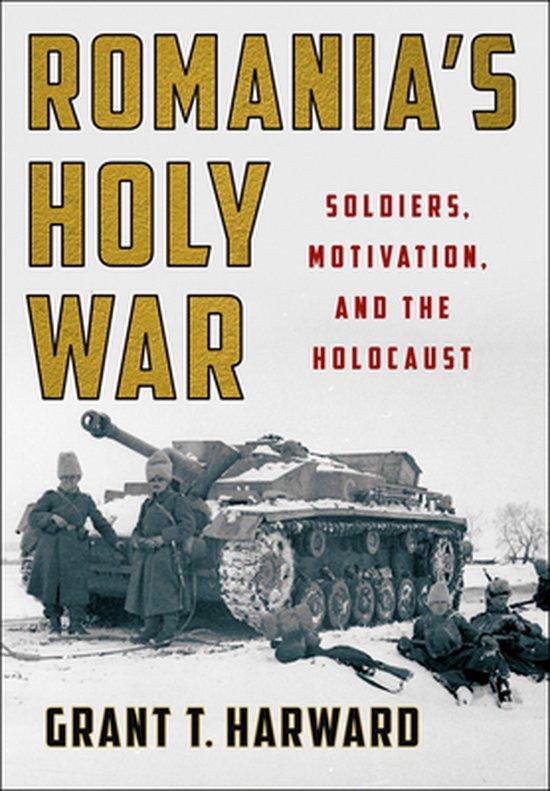| Title: | Romania’s Holy War - Soldiers, Motivation and the Holocaust |
| Writer: | Harward, Grant T. |
| Published: | Cornell University Press |
| Published in: | 2021 |
| Pages: | 360 |
| Language: | English |
| ISBN: | 9781501759963 |
| Review: | On June 22, 1941, Nazi Germany invaded the Soviet Union with the strongest military force ever witnessed in world history. Hitler's enormous army included Italian divisions, Spanish volunteers, Hungarians, Slovaks, and Croats. Additionally, the Waffen-SS would also incorporate volunteers from "Germanic" countries such as Denmark and the Netherlands. Hitler's two main military allies were Finland and Romania. Finland fought in the northern region, motivated to reclaim the territories it had to cede to the Soviet Union after the Winter War of 1939-1940. Romania faced a similar situation. On June 26, 1940, the country received a harsh ultimatum from Vyacheslav Molotov, the Soviet Minister of Foreign Affairs. It demanded that Romania cede the eastern province of Bessarabia and the northeastern part of Bukovina, or else the Soviet Union would declare war on Romania. German assistance could not be expected in the summer of 1940 due to the Molotov-Ribbentrop Pact. Romania had no choice but to comply. To make matters worse, under pressure from Germany and Italy, Romania had to cede more territory in August 1940. Hungary gained a portion of the Transylvania region, where a significant Hungarian population resided and which had previously been part of the Austro-Hungarian Dual Monarchy. The humiliating territorial losses sparked furious feelings of revenge in Romania, not only towards their arch-enemy Hungary but particularly towards the Soviet Union. Additionally, significant internal unrest emerged, leading to a change in monarchy (young Michael replacing his father Carol II) and, ultimately, a coup by Marshal Ion Antonescu. As a dictator ("conducător"), Antonescu governed Romania, initially with the support of the fascist Iron Guard. For Hitler, Romania held great strategic value, primarily due to its oil reserves. Despite bitterness over the previous lack of German support, Antonescu and his generals saw every reason to support Hitler's Russian campaign with a large Romanian army (which numbered over 600,000 men in the summer of '41). The seemingly invincible Wehrmacht would ultimately defeat godless communism, allowing the Romanians to liberate their lost provinces of Bessarabia and Bukovina. This would bring the longed-for "Greater Romania" ("Romania Mare") closer. Antonescu hoped that by proving himself as a reliable ally in this "holy war against Bolshevism," he would convince Hitler to return Transylvania to Romania after the final victory. Additionally, Antonescu hoped to add the territory conquered by Romanian troops from the Soviet Union (the so-called "Transnistria," including the city of Odessa) to Greater Romania. However, the over two million inhabitants of Transnistria were only partly Romanian—mostly Ukrainians, along with some "Volksdeutsche" (ethnic Germans) and a significant Jewish population. Those Jews would face a terrible fate. The entry of Romanian units was accompanied by a wave of atrocities. After the fall of Odessa in October '41, large-scale massacres also occurred there, resulting in the killing of tens of thousands of Jews, perhaps even up to 200,000, within six months. American historian Grant Harward, in his book, shows that this violent Romanian anti-Semitism was not limited to the conquered Soviet territory, nor did it only ignite during the Russian campaign. Even in the turbulent period preceding it, Romania, where hatred of Jews was widespread, had made Jews scapegoats, culminating in various pogroms. Understandably, the Aryan racial ideology of the German Nazis did not resonate with Romanians, but Antonescu and his regime also believed in the "Jewish-Bolshevik danger." Romanian units also participated in the initial phase of the Holocaust, where Jews were rounded up and shot by Einsatzgruppen. The history of Romanian collaboration with Hitler still needs to be written in a significant part. This is primarily due to the period after August 1944, when Romania was overrun by the Red Army, forced to turn against Nazi Germany, and became part of communist Eastern Europe. During the rule of dictator Nicolae Ceaușescu, silence was imposed regarding the collaboration years, especially the broad support that Antonescu's campaign against Russia initially enjoyed among the Romanian population. Only after 1989 could space finally be created for serious historical research, for example, to correct the unjust judgments found in the memoirs of former German generals, who claimed that the Romanian army was inferior and (together with the equally weak Italians) responsible for the Russian breakthrough at Stalingrad. There are not many Romanian (military) historians who publish in English, and few Western European and American researchers are proficient in the Romanian language. Grant Harward belongs to a select group, which also includes Vladimir Solonari (author of "A Satellite Empire: Romanian Rule in Southwestern Ukraine 1941-1944") and, of course, Dennis Deletant (author of the seminal work "Hitler's Forgotten Ally: Ion Antonescu and his Regime"). A notable fact is that Harward was able to interview fourteen Romanian veterans. The Romanian army proved to be Hitler's Wehrmacht's most important ally, fought resolutely, but was hindered by insufficient armament (especially tanks) and the sometimes inadequate leadership of the officer corps, which, largely trained in French defensive doctrines, was unfamiliar with the offensive principles of Blitzkrieg. Politically, Romanian soldiers were generally not neutral or indifferent – they believed in the "holy war" against the unbelieving Soviet Union and were no less anti-Semitic than their German comrades-in-arms. Harward has written a highly significant book that goes beyond mere military history. |
| Rating: |      Excellent Excellent |
Information
- Article by:
- Jan-Jaap van den Berg
- Published on:
- 27-05-2023
- Feedback?
- Send it!



